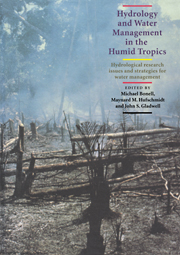 Hydrology and Water Management in the Humid Tropics
Hydrology and Water Management in the Humid Tropics Published online by Cambridge University Press: 23 December 2009
ABSTRACT
Northern Australia only includes the wet-dry tropical subregion of Chang and Lau's humid tropics; the remainder is within the dry tropics. However, the continent experiences some of the highest short-term rainfalls in the humid tropics which have significant ramifications for the hydrology and requirements for land conservation. This paper describes the limited Australian experience in change in land-use hydrology within the wet-dry tropics, and also devotes some attention to temperate Australian work, e.g., hydrology of eucalypt trees, to evaluate the potential for technology transfer. The account will commence with a brief statement of the four basic balance equations in hydrology and the characteristics which are relevant in the humid tropics and the general nature of Australia's research in these fields.
INTRODUCTION
The colloquium was held in Townsville in Northern Queensland at a latitude of 19°S and so was at the poleward limit of the humid tropics. However, the combination of geomorphology and seasonal wind patterns means that true humid tropic climate reaches within 100 km of Townsville. Significant hydrologic research on both basic hydrology and landscape management in the humid tropics also is based in Townsville.
This paper complements the basic paper on this topic by Lal (this volume) and presents an Australian viewpoint. It was prepared originally at short notice because ill-health seemed likely to preclude any contribution to the colloquium by Rattan Lal. The paper has now been modified to emphasize the nature of Australian research into land-use impacts generally. The limited nature of tropical rain forest and humid tropical hydrology in Australia means that this paper will focus in particular on the possibilities of technology transfer.
To save this book to your Kindle, first ensure [email protected] is added to your Approved Personal Document E-mail List under your Personal Document Settings on the Manage Your Content and Devices page of your Amazon account. Then enter the ‘name’ part of your Kindle email address below. Find out more about saving to your Kindle.
Note you can select to save to either the @free.kindle.com or @kindle.com variations. ‘@free.kindle.com’ emails are free but can only be saved to your device when it is connected to wi-fi. ‘@kindle.com’ emails can be delivered even when you are not connected to wi-fi, but note that service fees apply.
Find out more about the Kindle Personal Document Service.
To save content items to your account, please confirm that you agree to abide by our usage policies. If this is the first time you use this feature, you will be asked to authorise Cambridge Core to connect with your account. Find out more about saving content to Dropbox.
To save content items to your account, please confirm that you agree to abide by our usage policies. If this is the first time you use this feature, you will be asked to authorise Cambridge Core to connect with your account. Find out more about saving content to Google Drive.